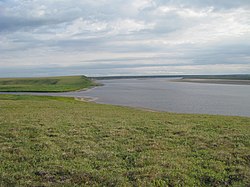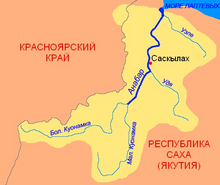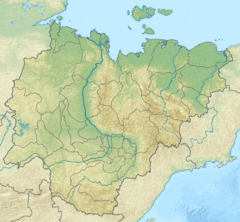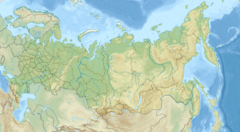Anabar (river): Difference between revisions
slight change to eliminate use of the pronoun "one" |
m link drainage basin |
||
| (30 intermediate revisions by 14 users not shown) | |||
| Line 1: | Line 1: | ||
| ⚫ | |||
{{coord|71.632|N|113.900|E|display=title}} |
|||
| name = Anabar |
|||
| ⚫ | |||
| other_name = Анабар / Анаабыр |
|||
|river_name = Anabar River |
|||
| image = Anabar river near the mouth of Polovinnaya tributary, р. Анабар, устье р. Половинной - panoramio.jpg |
|||
|image_name = |
|||
| image_caption = The Anabar near the mouth of the Polovinnaya |
|||
|caption = |
|||
| |
| map = Anabar.png |
||
| map_size = |
|||
| ⚫ | |||
| map_caption = Anabar river basin |
|||
| ⚫ | |||
| map_alt = |
|||
|length = 939 km (583 mi) |
|||
| pushpin_map = Russia Sakha Republic#Russia |
|||
|elevation = |
|||
| pushpin_map_size = |
|||
|discharge = 498 m³/s |
|||
| pushpin_map_caption= Location of the mouth |
|||
|watershed = 100,000 km² |
|||
| pushpin_map_alt = |
|||
| source1 = Confluence of [[Malaya Kuonamka]] and [[Bolshaya Kuonamka]] |
|||
| source1_location = [[Olenyoksky District|Olenyoksky District, Sakha]] |
|||
| source1_coordinates = {{coord|70|46|16|N|113|20|13|E|}} |
|||
| source1_elevation = {{convert|16|m|abbr=on}} |
|||
| ⚫ | |||
| mouth_location = [[Anabar Bay]] |
|||
| mouth_coordinates = {{coord|73.2052|113.5567|source:wikidata|display=it}} |
|||
| mouth_elevation = {{convert|0|m|abbr=on}} |
|||
| subdivision_type1 = Country |
|||
| ⚫ | |||
| length = {{convert|380|km|mi|abbr=on}} ({{convert|939|km|mi|abbr=on}}) |
|||
| discharge1_avg = {{convert|498|m3/s|cuft/s|abbr=on}} |
|||
| basin_size = {{convert|100000|km2|mi2|abbr=on}} |
|||
}} |
}} |
||
The '''Anabar |
The '''Anabar''' ({{lang-rus|Анабар|r=Anabar}}, in its upper course: Большая Куонамка ''Bolshaya Kuonamka''; {{lang-sah|Анаабыр|translit=Anaabır}}) is a [[river]] in [[Sakha Republic|Sakha]], [[Russia]]. It is {{convert|380|km}} long ({{convert|939|km|mi|abbr=on}} counting the {{convert|559|km|mi|abbr=on}} long Bolshaya Kuonamka ("Big Kuonamka") stretch of its upper course) and has a [[drainage basin]] of {{convert|100000|km2}}.<ref name=gvr>{{GVR|233759|Река Анабар (Бол. Куонапка)}}</ref> |
||
==Course== |
|||
Its mean annual discharge is approximately {{convert|500|m3/s|cuft/s}}, concentrated heavily in early summer when the ice that covers the river for most of the year thaws. The [[Gulf of Anabar]] is believed to be the easternmost [[fjord]] in Russia – defining the point at which the climate during the [[Last Glacial Maximum]] became too dry for [[glaciers]] to form. A clear transition from fjords to deltas at river mouths is apparent shortly to the east at the [[Lena River]] [[river delta|delta]]. |
|||
The Anabar is formed at the confluence of the [[Malaya Kuonamka]] and [[Bolshaya Kuonamka]] at the edge of the [[North Siberian Lowland]]. The length of the Anabar proper is {{convert|380|km|mi|abbr=on}}. The two rivers forming it have their sources in the northeastern part of the [[Anabar Plateau]], part of the [[Central Siberian Plateau]]. There are many lakes in its basin. |
|||
The Anabar basin is located between rivers [[Khatanga (river)|Khatanga]] and [[Olenyok (river)|Olenyok]]. The mouth of the river is in the [[Anabar Bay]]. Its mean annual discharge is {{convert|564|m3/s|cuft/s}}, concentrated heavily in early summer when the ice that covers the river for most of the year thaws.<ref name=WR/> The [[Uele (Yakutia)|Uele]] river flows into the Laptev Sea close to the mouth of the Anabar, but it is not its tributary.<ref name=GE>[[Google Earth]]</ref> |
|||
| ⚫ | |||
== |
===Tributaries=== |
||
Its main tributaries are the {{convert|115|km|mi|abbr=on}} long [[Mayat]], the {{convert|342|km|mi|abbr=on}} long [[Udya]] (Удьа), the {{convert|453|km|mi|abbr=on}} long [[Malaya Kuonamka]] ("Little Kuonamka") and the {{convert|108|km|mi|abbr=on}} long [[Ebelyakh]] on the right, as well as the {{convert|262|km|mi|abbr=on}} long [[Suolama]], the {{convert|139|km|mi|abbr=on}} long Kharabyl and the {{convert|103|km|mi|abbr=on}} long [[Konnies]] on the left.<ref name=WR>[https://water-rf.ru/%D0%92%D0%BE%D0%B4%D0%BD%D1%8B%D0%B5_%D0%BE%D0%B1%D1%8A%D0%B5%D0%BA%D1%82%D1%8B/1042/%D0%90%D0%BD%D0%B0%D0%B1%D0%B0%D1%80 Water of Russia - Анабар]</ref> |
|||
==History== |
|||
Historically [[Evenks]] have inhabited the basin of the Anabar River.<ref name=Forsyth>{{cite book |
Historically [[Evenks]] have inhabited the basin of the Anabar River.<ref name=Forsyth>{{cite book |
||
| last = Forsyth |
| last = Forsyth |
||
| Line 28: | Line 45: | ||
| year = 1992 |
| year = 1992 |
||
| location = Cambridge |
| location = Cambridge |
||
}}</ref> Vasiliy Sychev was the first [[Russia]]n to reach the river in 1643.<ref name=Armstrong>{{cite book |
|||
| last = Armstrong |
| last = Armstrong |
||
| first = Terence |
| first = Terence |
||
| Line 34: | Line 51: | ||
| publisher = Cambridge University Press |
| publisher = Cambridge University Press |
||
| year = 2010 |
| year = 2010 |
||
| ⚫ | |||
| isbn = |
|||
| url = |
|||
| ⚫ | |||
| last = Holland |
| last = Holland |
||
| first = Clive |
| first = Clive |
||
| Line 43: | Line 58: | ||
| year = 1994 |
| year = 1994 |
||
| location = New York |
| location = New York |
||
| ⚫ | |||
| url = |
|||
| ⚫ | |||
| ⚫ | In present times the basin of the Anabar river is notable as the location of the largest concentration of [[diamond]] deposits in the world outside of [[Africa]] and [[Australia]]. These deposits made the [[Soviet Union]] into one of the world's largest producers of diamonds, and remain the economic mainstay of the area. |
||
==See also== |
|||
*[[List of rivers of Russia]] |
|||
==References== |
==References== |
||
{{Reflist}} |
{{Reflist}} |
||
==External links== |
|||
*{{commonscat inline|Anabar River}} |
|||
{{Authority control}} |
|||
[[Category:Rivers of the Sakha Republic]] |
[[Category:Rivers of the Sakha Republic]] |
||
[[Category:Drainage basins of the Laptev Sea]] |
[[Category:Drainage basins of the Laptev Sea]] |
||
[[Category:North Siberian Lowland]] |
|||
Latest revision as of 14:32, 28 March 2024
| Anabar Анабар / Анаабыр | |
|---|---|
 The Anabar near the mouth of the Polovinnaya | |
 Anabar river basin | |
| Standort | |
| Land | Russland |
| Physical characteristics | |
| Source | Confluence of Malaya Kuonamka and Bolshaya Kuonamka |
| • location | Olenyoksky District, Sakha |
| • coordinates | 70°46′16″N 113°20′13″E / 70.77111°N 113.33694°E |
| • elevation | 16 m (52 ft) |
| Mouth | Laptev Sea |
• location | Anabar Bay |
• coordinates | 73°12′19″N 113°33′24″E / 73.2052°N 113.5567°E |
• elevation | 0 m (0 ft) |
| Length | 380 km (240 mi) (939 km (583 mi)) |
| Basin size | 100,000 km2 (39,000 sq mi) |
| Discharge | |
| • average | 498 m3/s (17,600 cu ft/s) |
The Anabar (Russian: Анабар, romanized: Anabar, in its upper course: Большая Куонамка Bolshaya Kuonamka; Yakut: Анаабыр, romanized: Anaabır) is a river in Sakha, Russia. It is 380 kilometres (240 mi) long (939 km (583 mi) counting the 559 km (347 mi) long Bolshaya Kuonamka ("Big Kuonamka") stretch of its upper course) and has a drainage basin of 100,000 square kilometres (39,000 sq mi).[1]
Course
[edit]The Anabar is formed at the confluence of the Malaya Kuonamka and Bolshaya Kuonamka at the edge of the North Siberian Lowland. The length of the Anabar proper is 380 km (240 mi). The two rivers forming it have their sources in the northeastern part of the Anabar Plateau, part of the Central Siberian Plateau. There are many lakes in its basin.
The Anabar basin is located between rivers Khatanga and Olenyok. The mouth of the river is in the Anabar Bay. Its mean annual discharge is 564 cubic metres per second (19,900 cu ft/s), concentrated heavily in early summer when the ice that covers the river for most of the year thaws.[2] The Uele river flows into the Laptev Sea close to the mouth of the Anabar, but it is not its tributary.[3]
Tributaries
[edit]Its main tributaries are the 115 km (71 mi) long Mayat, the 342 km (213 mi) long Udya (Удьа), the 453 km (281 mi) long Malaya Kuonamka ("Little Kuonamka") and the 108 km (67 mi) long Ebelyakh on the right, as well as the 262 km (163 mi) long Suolama, the 139 km (86 mi) long Kharabyl and the 103 km (64 mi) long Konnies on the left.[2]
History
[edit]Historically Evenks have inhabited the basin of the Anabar River.[4] Vasiliy Sychev was the first Russian to reach the river in 1643.[5][6]
In present times the basin of the Anabar river is notable as the location of the largest concentration of diamond deposits in the world outside of Africa and Australia. These deposits made the Soviet Union into one of the world's largest producers of diamonds, and remain the economic mainstay of the area.
See also
[edit]References
[edit]- ^ "Река Анабар (Бол. Куонапка) in the State Water Register of Russia". textual.ru (in Russian).
- ^ a b Water of Russia - Анабар
- ^ Google Earth
- ^ Forsyth, James (1992). A History of the Peoples of Siberia: Russia's North Asian colony 1581-1990. Cambridge: Cambridge University Press.
- ^ Armstrong, Terence (2010). Russian Settlement in the North. Cambridge University Press.
- ^ Holland, Clive (1994). Arctic Exploration and Development, c. 500 B.C. to 1915: an encyclopedia. New York: Garland.
External links
[edit] Media related to Anabar River at Wikimedia Commons
Media related to Anabar River at Wikimedia Commons


